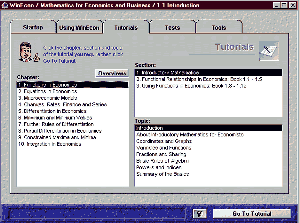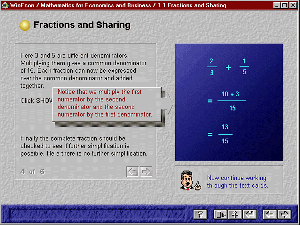Volume 13, Issue 1, 1999
Review of Mathematics for Economics and Business : An Interactive Introduction
Mathematics for Economics and Business : An Interactive Introduction
by Jean Soper
294 pages, with CD-ROM containing MathEcon 5.1
Blackwell Publishers 1999.
ISBN 0-631-21189-6 Hardback £50
ISBN 0-631-20781-3 Paperback £18.99
Reviewed by:
- Guy Judge and Rebecca Taylor
- University of Portsmouth
Although there are many books on the market which cover the subject of Mathematics for Economists, Jean Soper’s book will be widely welcomed. One reason for this is because of its links with MathEcon, part of the WinEcon software that has been repurposed to go with this book. Students at many universities, especially in the UK, are already using the WinEcon software alongside the more traditional resources of lectures, classes and textbooks on introductory classes in basic economics. Since many of these students are also required to take courses in Mathematics for Economists, they are likely to be receptive to using the MathEcon software and a book which has been prepared especially to go with it. Lecturers too will be pleased with the package which allows students to work more effectively on their own.
However there are other features of this book which make it an attractive choice for students and for lecturers who must recommend course textbooks.
Coverage
The book covers most of the topics likely to be needed by first year students of economics, although one could argue that some additional topics such as elementary matrix algebra and linear programming could be included. Although the book is primarily intended for students with only GCSE maths, some universities teach post A level and non A level maths students together, adding in topics such as these. So this book would not cover all the topics on such courses. Conversely we were pleased to see that chapter 1 goes over elementary material such as fractions, powers and indices and basic algebra. This elementary material, which experienced lecturers know needs to be revised, is often omitted from Maths for Economics texts. It can be frustrating for students if their recommended textbook doesn't contain material relating to the first few weeks of the course so we were pleased to see it here. Students at Portsmouth are encouraged to buy an additional text - Refresher Mathematics - and the additional cost often means that only the very dedicated students learn the basic concepts early on in the course. Having this section as part of the main course text will mean that many more students will have the tools at hand to learn, or refresh themselves, on the fundamental concepts. We also approve of the inclusion of the material on the use of the calculator, and briefly too on spreadsheets, as we like to include discussion of the use of such tools on our courses.
One of the concepts that often requires explanation is what logarithms and exponents actually are. While the sections in this book covering these topics provide a good explanation of how they are used, it would have been helpful to have had a little more introductory material on what exactly the concepts are and why they are relevant to economists.
Generally, though, the book develops concepts in a way that complements the topics that the students cover in their introductory economics courses. Students often fail to see how the mathematical concepts they learn relate to economics and this text tackles the issue very well.

Figure 1a. MathEcon topic list
Click above to download the images
Market
We think the market for this book is mainly economics rather than business students. However lines are becoming more blurred with the popularity of Business Economic degrees. Also the chapter on macroeconomic models, which would be of least interest to business studies students, could be skipped without disrupting the flow of ideas. Conversely Chapter 4, with the material it includes on finance, will be welcomed by lecturers teaching students on Financial Services degrees.
Layout
The book is clearly and attractively laid out. Each chapter has well-defined objectives and step by step tuition with fully set out worked examples. We particularly like the "Remember" boxes and the cross references to the MathEcon screens (possibly another little icon could have been used here?)
Writing style
Jean Soper has a clear and easy to read writing style. She shows attention to detail that reflects her classroom experience. For example in Chapter 1 she explains that –6 is smaller than –2. Often such points are skipped over and some students become confused. In a couple of places we found Jean’s comments about how to get good grades and exam marks a bit irritating - but there is no doubt that this is of primary concern to students so it probably won’t annoy them!

Figure 2. A typical MathEcon screen
Click above to download the images
MathEcon
The program was easy to install and use. Particularly attractive was the ability to generate worked examples with randomized numerical values. Students like to have plenty of examples to quiz themselves with and it can take the pressure off the lecturer too. One minor quibble was the use of P rather than P for profit on some screens. The idea of additional question sheets in pdf format is a good one, but some chapters don’t seem to offer very many questions. More should be added for any future editions of the software. The glossary seems to apply to the full WinEcon program rather than just MathEcon, but we like the idea of the link to biz/ed. We would recommend that future editions of MathEcon make greater use of web links to places where students can find more on-line material, further multiple choice questions, or biographical details of key figures in the development of the subject.
Overall we believe that the book is very user friendly and that the feedback from students will be positive. It will be particularly interesting to see whether the addition of the basic algebra section will bring the weaker students up to the necessary level more quickly, and if the students find the tutorials on the CD-ROM an element that successfully reinforces the taught concepts.

